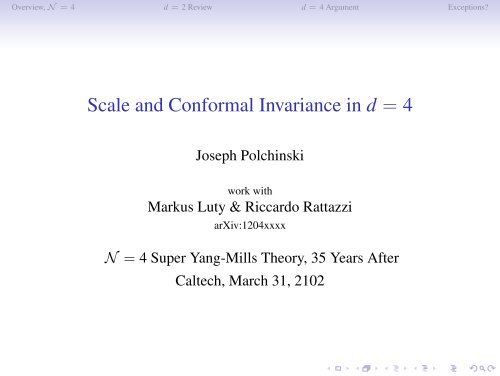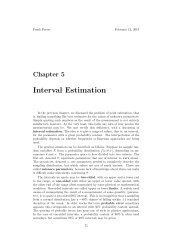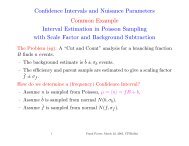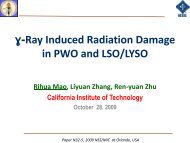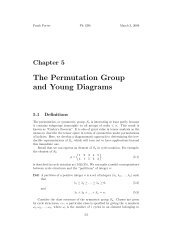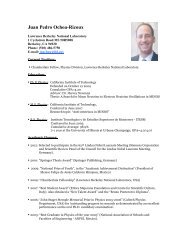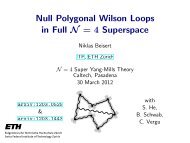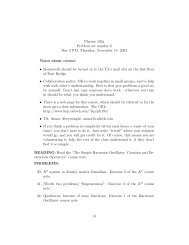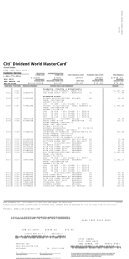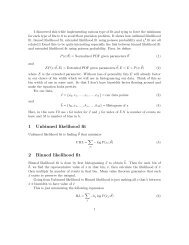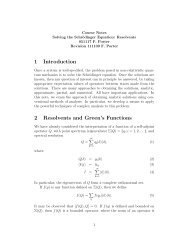Scale and Conformal Invariance in d=4
Scale and Conformal Invariance in d=4
Scale and Conformal Invariance in d=4
You also want an ePaper? Increase the reach of your titles
YUMPU automatically turns print PDFs into web optimized ePapers that Google loves.
Overview, N = 4 d = 2 Review d = 4 Argument Exceptions?<strong>Scale</strong> <strong>and</strong> <strong>Conformal</strong> <strong>Invariance</strong> <strong>in</strong> d = 4Joseph Polch<strong>in</strong>skiwork withMarkus Luty & Riccardo RattazziarXiv:1204xxxxN = 4 Super Yang-Mills Theory, 35 Years AfterCaltech, March 31, 2102
Overview, N = 4 d = 2 Review d = 4 Argument Exceptions?Overview: <strong>Scale</strong> vs. <strong>Conformal</strong> <strong>Invariance</strong>(a) orig<strong>in</strong>al (b) scale (c) conformalIt is difficult to f<strong>in</strong>d quantum field theories that are scale <strong>in</strong>variantwithout be<strong>in</strong>g fully conformal <strong>in</strong>variant.In d = 2 there is a close connection between this question <strong>and</strong> themonotonicity of the RG flow (Zamolodchikov ’86; JP ’88)We will try to exploit recent progress <strong>in</strong> the underst<strong>and</strong><strong>in</strong>g of the RGflow <strong>in</strong> d = 4 (Komargodski & Schwimmer 1107.3987;Komargodski 1112.4538).
Overview, N = 4 d = 2 Review d = 4 Argument Exceptions?<strong>Scale</strong> vs. <strong>Conformal</strong> <strong>Invariance</strong>A general scale current has the form (Wess)S µ = T µ νx ν + V µ ,where T µ µ is the stress-energy tensor <strong>and</strong> V µ is often called the virialcurrent. Conservation of the scale current implies that0 = ∂ µ S µ ⇒ T µ µ = −∂ µ V µ<strong>Scale</strong> <strong>in</strong>variance allows any vector operator V µ , but <strong>in</strong> order toconstruct conformal generators we need the stronger conditionV µ = ∂ ν L µνfor some L µν . (Equivalently, there is an improved T µν whose tracevanishes.)
Overview, N = 4 d = 2 Review d = 4 Argument Exceptions?C<strong>and</strong>idate virialsIn many cases there simply is no nontrivial c<strong>and</strong>idate for V µ . Forexample, <strong>in</strong> Banks-Zaks, a non-Abelian gauge field coupled to N ffundamentals <strong>and</strong> antifundamentals, with N f /N c = 112− ɛ: (1) Thefermionic vector current j µ V is conserved. (2) The fermionic axialcurrent j µ V is odd under CP; s<strong>in</strong>ce we can rotate θ to zero the theory isCP-symmetric <strong>and</strong> the axial current cannot appear. (3) TheChern-Simons current V µ dx µ = ∗ Tr(AdA + 2A 3 /3) is not gauge<strong>in</strong>variant. So this theory is conformal.But this argument is not general enough: by add<strong>in</strong>g scalars <strong>and</strong>Yukawa coupl<strong>in</strong>gs, we can get many cases where c<strong>and</strong>idate virialsexist but do not actually appear <strong>in</strong> S µ .
Overview, N = 4 d = 2 Review d = 4 Argument Exceptions?N = 4 SYMBy the way, how do we know that the birthday theory is actuallyconformally <strong>in</strong>variant? One possible virial is the gradient of theKonishi operator, ∂ µ (Φ a Φ a ), but this can be improved away. But thefermionic U(1) currentV µ = ¯ψ i σ µ ψ i ?is not conserved (broken by Yukawa coupl<strong>in</strong>gs), so is a c<strong>and</strong>idate. It isCP-odd, so can’t appear at θ = 0, but could conceivably be generatedby <strong>in</strong>stantons at nonzero θ.But of course, supersymmetry will impose strong constra<strong>in</strong>ts...
Overview, N = 4 d = 2 Review d = 4 Argument Exceptions?Howe, Stelle & Townsend, M<strong>and</strong>elstam ’82 <strong>and</strong> Br<strong>in</strong>k, L<strong>in</strong>dgren &Nilsson ’82 prove perturbative f<strong>in</strong>iteness — does this implyconformal <strong>in</strong>variance? Multiplet of anomalies (Sohnius <strong>and</strong> West ’81)seems to show that T µ µ = 0, even nonperturbatively.Modern argument (Seiberg ’88): For scale <strong>in</strong>variance, go out on theCoulomb branch parameterized by Φ. Effective gauge Lagrangian is12g 2 (Φ) Tr F µνF µν .N = 4 forbids a field-dependent k<strong>in</strong>etic term, so g 2 must be<strong>in</strong>dependent of scale. If there is a nontrivial virial, the effective actionmust reflect this through a term of the form1Φ ∂ µΦV µ .Aga<strong>in</strong> this is ∼ nonl<strong>in</strong>ear two-derivative term, forbidden by N = 4.
Overview, N = 4 d = 2 Review d = 4 Argument Exceptions?Review of d = 2 argumentThe arguments thus far are rather special. In d = 2 there is a generalresult. From conservation of T µν ,x µwhere G µν,σρ = 〈0|T µν (x)T σρ (0)|0〉 <strong>and</strong>∂∂x µ c(x) = −24z2¯z 2 G z¯z,z¯z , (1)c(x) = 2z 4 G zz,zz − 4z 3¯zG z¯z,zz − 6z 2 G z¯z,z¯z . (2)We are us<strong>in</strong>g the improved energy-momentum tensor, which scalescanonically. In a scale <strong>in</strong>variant theory, c(x) is <strong>in</strong>dependent of theseparation, so 〈0|T z¯z (x)T z¯z (0)|0〉 = 0, imply<strong>in</strong>g that <strong>in</strong> a unitarytheory the trace T z¯z vanishes.
Overview, N = 4 d = 2 Review d = 4 Argument Exceptions?In a nonunitary theory there might be exceptions, as the vanish<strong>in</strong>g ofthe two-po<strong>in</strong>t function of the trace need not imply the vanish<strong>in</strong>g of thetrace: we will see an example later.Exceptions can also arise if the field theory does not have anormalizable ground state, so that the two-po<strong>in</strong>t function does notexist. One class consists of nonl<strong>in</strong>ear sigma models whose targetspace geometry satisfiesR ij = ∇ (i ξ j)(Hull <strong>and</strong> Townsend; Tseytl<strong>in</strong> ’86) <strong>Conformal</strong> <strong>in</strong>variance requiresfurther that ξ i be a gradient ∂ i f . Such manifolds are necessarilynoncompact, there is no normalizable ground state.
Overview, N = 4 d = 2 Review d = 4 Argument Exceptions?d = 4: Brief KS reviewKomargodsky <strong>and</strong> Schwimmer monotonicity argument <strong>in</strong> d = 4: puta QFT <strong>in</strong> a background metric ĝ µν (x). Splitĝ µν (x) = e −2τ(x) g µν (x) .Exp<strong>and</strong> around g µν = η µν <strong>and</strong> look at the 4-dilaton S-matrix.On-shell condition is□ϕ = 0 , ϕ/f = 1 − e −τ ;(dilaton = background field). If the QFT is conformal (over somerange of scales), ϕ decouples from it <strong>and</strong> the ϕϕ → ϕϕ amplitudecomes only from the effective local Wess-Zum<strong>in</strong>o term aS WZ =
Overview, N = 4 d = 2 Review d = 4 Argument Exceptions?The anomaly σE 4 anomaly underKS review∫aS WZ = a d 4 x √ gτE 4 + . . .∫→ −2a d 4 x (∂ µ ϕ∂ µ ϕ) 2 .τ → τ + σ ,g µν e 2σis the same at all scales (zero, here) <strong>and</strong> equal to a CFT − a at scaleswhere the theory is conformal.By a dispersive argument, a decreases toward the IR, soa CFT,IR < a CFT,UV .
Overview, N = 4 d = 2 Review d = 4 Argument Exceptions?Evaluateon∫ dss 3 M ϕϕ→ϕϕThe <strong>in</strong>tegral on I 2 is nonnegative <strong>and</strong> (positive if the cross-section isnonzero).Now, use these <strong>in</strong>gredients to address scale vs. conformal.
Overview, N = 4 d = 2 Review d = 4 Argument Exceptions?<strong>Scale</strong> vs. conformal(i) In a conjectured SFT (scale but not conformal theory), the dilatonwill not decouple (Nakayama, 1110.2586):τT µ µ = −τ∂ µ V µ .The ττ → SFT cross section is then generically nonzero, <strong>and</strong> by scale<strong>in</strong>variance ∝ f −4 s. The dispersive argument then implies alogarithmic runn<strong>in</strong>g of a.
Overview, N = 4 d = 2 Review d = 4 Argument Exceptions?<strong>Scale</strong> vs. conformal(i) In a conjectured SFT (scale but not conformal theory), the dilatonwill not decouple (Nakayama, 1110.2586):τT µ µ = −τ∂ µ V µ .The ττ → SFT cross section is then generically nonzero, <strong>and</strong> by scale<strong>in</strong>variance ∝ f −4 s. The dispersive argument then implies alogarithmic runn<strong>in</strong>g of a.(ii) Such a logarithmic runn<strong>in</strong>g is <strong>in</strong>consistent, so an SFT cannot exist.
Overview, N = 4 d = 2 Review d = 4 Argument Exceptions?Inconsistency of runn<strong>in</strong>g of aExp<strong>and</strong> on (ii): consider the theory constructed <strong>in</strong> the background ĝ µν<strong>and</strong> def<strong>in</strong>ed by a UV cutoff (or flow from a UV CFT) at scale Λ.At a much lower scale µ, the effective lagrangian will conta<strong>in</strong> a termC log(Λ/µ)(∂ µ ϕ∂ µ ϕ) 2 .The UV-divergent part must be completed to an <strong>in</strong>teraction that is (a)local <strong>and</strong> (b) a function only of ĝ µν . But it can’t: it comes only from alocal term that has an anomalous variation.
Overview, N = 4 d = 2 Review d = 4 Argument Exceptions?Perturbative fixed po<strong>in</strong>ts(i) It rema<strong>in</strong>s to show that the log divergence is actually there. Forweakly coupled CFT’s we can do this explicitly. The lead<strong>in</strong>g coupl<strong>in</strong>gof the dilaton is throughτT µ µ = ( ϕ + 1 2 ϕ2 + . . . ) T µ µHereT µ µ = ∑ Aβ A O ASFT= g A Q AB O B .Next order is of the formτ 2 (∂ 2 µg A )O A ∼ ϕ 2 β B ∂ gB β A O A<strong>and</strong> is suppressed by ∂ gB β A ≪ 1 at a weakly coupled fixed po<strong>in</strong>t.
Overview, N = 4 d = 2 Review d = 4 Argument Exceptions?Perturbative fixed po<strong>in</strong>tsEach vertex br<strong>in</strong>gs <strong>in</strong> one factor of T µ µ ∝ β, so (a) dom<strong>in</strong>ates at weakcoupl<strong>in</strong>g,∫d 4 x e ip·x β 2 A〈0|O A (x)O A (0)|0〉 = c A β 2 A(Komargodsky 1112.4538). QED.∫d 4 x eip·xx −8 ∝ c Aβ 2 As 2 ln Λ s .
Overview, N = 4 d = 2 Review d = 4 Argument Exceptions?Perturbative fixed po<strong>in</strong>tsWe can make an <strong>in</strong>dependent argument based on (c), because (a) <strong>and</strong>(b) constribute only to s-wave scatter<strong>in</strong>g. For l ≥ 1, (c) makes anunambiguously positive contribution to the cross section, e.g.
Overview, N = 4 d = 2 Review d = 4 Argument Exceptions?Perturbative fixed po<strong>in</strong>tsEither way, weakly coupled SFT’s are ruled out.Theories with discrete scale <strong>in</strong>variance also excluded, as is any flowfor which∫ dµµ β2diverges <strong>in</strong> either the IR or the UV.
Overview, N = 4 d = 2 Review d = 4 Argument Exceptions?Strongly coupled fixed po<strong>in</strong>tsCould these cancel, for all <strong>in</strong>termediate states? It seems unlikely. Itrequires, e.g.〈0|T T µ µ(x 1 )T ν ν(x 2 )T σ σ(x 3 )T ρ ρ(x 4 )|0〉const=(x 1 − x 2 ) 4 + 2 perms. + just-right contact terms ,(x 3 − x 4 ) 4Impossible?
Overview, N = 4 d = 2 Review d = 4 Argument Exceptions?Exceptions? I. Nonrenormalizable scalar theoryColeman <strong>and</strong> Jackiw ’71:L = ∂Φ∂Φ + (∂Φ∂Φ)2Φ 4 .Nonrenormalizable, but could be treated as an effective Lagrangianbelow the scale Φ. The background Φ breaks scale <strong>in</strong>variance, soσ ϕϕ→SFT ∝s5f 4 Φ 8(rather than s/f 4 ). Octic divergence rather than a log, canceled byΦ −8 , leav<strong>in</strong>g O(1) which can be canceled by UV thresholdcontribution: no contradiction.Φ ≠ 0: there is no scale <strong>in</strong>variant background.
Overview, N = 4 d = 2 Review d = 4 Argument Exceptions?Exceptions? II. ElasticityTheory of elasticity (Callan, Coleman <strong>and</strong> Jackiw ’70; Riva <strong>and</strong>Cardy hep-th/0504197). Displacement u µ (x) with action∫d d x √ [ 1g4 (∂ µu ν − ∂ ν u µ )(∂ µ u ν − ∂ ν u µ ) + h ]2 (∇ µu µ ) 2 .Not reflection positive/unitary. <strong>Scale</strong> but not conformally <strong>in</strong>variant <strong>in</strong>any d. In d = 4 the coupl<strong>in</strong>gs to the dilaton are2h ( ∂ µ u µ u ν ∂ ν ϕ + ∂ µ u µ ϕ u ν ∂ ν ϕ + (u µ ∂ µ ϕ) 2) .Even though it is nonunitary, it provides a check on argument (ii): thelog divergence should not appear.
Overview, N = 4 d = 2 Review d = 4 Argument Exceptions?Exceptions? II.Individual graphs have log divergences proportional to a + bh + ch 2 ,but the sum is zero. Exclusive amplitudes are nonzero <strong>and</strong> have bothlocal <strong>and</strong> contact pieces, but the total ‘cross section’ is zero.
adm<strong>in</strong>istración de la morosidad e <strong>in</strong>existencia de provisiones para cuentas<strong>in</strong>cobrables y factores externos tales como: políticas en el ámbitomacroeconómico, escasez de fuentes de empleo, <strong>in</strong>flación, moralidadcomercial del cliente, <strong>in</strong>solvencia del cliente. Aunque cabe mencionar que<strong>in</strong>dependientemente del factor que produzca la morosidad, ésta ocasionagr<strong>and</strong>es pérdidas económicas y materiales a los comerciantes.1.1.3 Prospectiva del problemaEn caso de no contrarrestar la problemática de la morosidad quedesde años atrás y hasta hoy en día atraviesan las empresas que operanbajo el sistema de créditos en la ciudad de Atuntaqui, dichoscomerciantes atravesarán por problemas de liquidez, que ocasionará queestos <strong>in</strong>curran en el <strong>in</strong>cumplimiento de sus obligaciones con terceraspersonas, cre<strong>and</strong>o un círculo vicioso de la morosidad y de no conseguirque los comerciantes antes de apostarle a las ventas a crédito como unatáctica de lucha contra la competencia, def<strong>in</strong>an políticas y l<strong>in</strong>eamientoscrediticios adecuados, que les permitan un adecuado control de lasmismas, podrían entorpecer el normal funcionamiento de sus actividadese <strong>in</strong>cluso llevar al negocio hacia la quiebra.1.2 Formulación del problema¿Cuál es la <strong>in</strong>cidencia de la morosidad en la rentabilidad del sectorcomercial que opera bajo el sistema de créditos, en la ciudad deAtuntaqui, durante el período del año 2010?1.3 Objetivos de la <strong>in</strong>vestigación1.3.1 Objetivo general‣ Determ<strong>in</strong>ar la <strong>in</strong>cidencia de la morosidad en la rentabilidad delsector comercial que opera bajo el sistema de créditos, en la ciudadde Atuntaqui, durante el período del año 2010.2
Overview, N = 4 d = 2 Review d = 4 Argument Exceptions?Exceptions? IV. d = 4 BZFGSFGS also have at least one weakly coupled c<strong>and</strong>idate example <strong>in</strong>d = 4, us<strong>in</strong>g a Banks-Zaks sector to provide a small parameter.This example has a potential unbounded below, but this should not<strong>in</strong>validate our argument based on UV divergences.There is the possibility that three-loop terms will make V µ cancel.Our argument predicts that this will occur.
Overview, N = 4 d = 2 Review d = 4 Argument Exceptions?ConclusionsThe arguments, both for monotonicity <strong>and</strong> nonexistence of SFT’s, arevery dimension-dependent. Is there a general pr<strong>in</strong>ciple?We have illum<strong>in</strong>ated one small corner of the space of possiblequantum field theories. Thanks <strong>in</strong> large part to lessons learned fromN = 4, quantum field theory still reta<strong>in</strong>s a primary role <strong>in</strong> the searchfor a ‘theory of everyth<strong>in</strong>g.’


